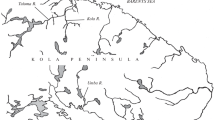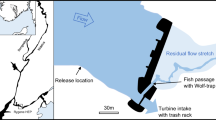Abstract
We study the evolution of polymorphic life histories in anadromous semelparous salmon and the effects of harvesting. We derive dynamic phenotypic and genetic ESS models for describing the evolutionary dynamics. We show in our deterministic analysis that polymorphisms are not possible in a panmictic random mating population. Instead, genetic or behavioral polymorphisms may be observed in populations with assortative mating systems. Positive assortative mating may be supported and generated by behavioral and phenotypic traits like male mate choice, spawning ground selection by phenotype, or within-river homing-migration-distance by size. In the case of an evolutionarily stable dimorphism, the ESS is characterized by a reproductive ideal free distribution such that at an equilibrium the individuals are indifferent from the fitness point of view between the two life histories of early and late reproduction. Different strategy models - that is, phenotypic and genetic ESS models - yield identical behavioral predictions and, consequently, genetics does not seem to play an important role in the present model. An evolutionary response to increased fishing mortality is obvious and may have resource management implications. High sea fishing mortalities drive the populations toward early spawning. Thus it is possible that unselective harvesting at sea may eliminate, depending on the biological system, behavioral polymorphisms or genetic heterozygozity and drive the population to a monomorphic one. If within-river homing migration distances depend on the size of fish, unselective harvesting at sea, or selective harvesting of spawning runs in rivers, may reduce local population sizes on spawning grounds high up rivers. Finally, harvesting in a population may cause a switch in a dominant life-history strategy in a population so that anticipated sustainable yields cannot be realized in practice.
Similar content being viewed by others
References
Armstrong, R. A., McGehee, R.: Competitive exclusion, American Naturalist 115, 151–170 (1980)
van Baalen, M., Sabelis, M. W.: Coevolution of patch selection strategies of predator and prey and the consequences for ecological stability, American Naturalist 142, 446–470 (1993)
Bergh, M. O., Getz, W. M.: Stability of discrete age-structured and aggregated delay-difference population models. Journal of Mathematical Biology 26, 551–581 (1988)
Bergh, M. O., Getz, W. M.: Stability and harvesting of competing populations with genetic variation in life history strategies, Theoretical Population Biology 36, 77–124 (1989)
Brown, J., Vincent, T.: A theory for the evolutionary game, Theoretical Population Biology 31, 140–166 (1987)
Charlesworth, B.: Evolution in age-structured populations. Cambridge University Press, Cambridge (1980)
Edelstein-Keshet, L.: Mathematical Models in Biology, Random House, New York: 1989
Ellner, S.: ESS germination rates in randomly varying environments. l. Logistic type models. Theoretical Population Biology 28, 50–79 (1985a)
Ellner, S.: ESS germination rates in randomly varying environments. 11. Reciprocal yield-law type models. Theoretical Population Biology 28, 80–116 (1985b)
Ferriere, R. H., and Gatto, M.: Chaotic populations dynamics can result from natural selection. Proc. R. Soc. Lond. B, 51, 33–38 (1993).
Fisher, A. C., Hanemann, W. M., Keeler, A. G.: Integrating fishery and water resource management: A biological model of a California salmon fishery, Journal of Environmental Economics and Management 20, 234–261 (1991)
Foote, C. J.: Male mate choice dependent on male size in salmon. Behaviour 106, 63–80 (1988)
Foote, C. J., Larkin, P. A.: The role of male choice in assortative mating of sockey salmon and kokanee, the anadromous and nonanadromous forms of Oncorhychus nerka. Behaviour 106, 43–62 (1988)
Fraidenburg, M. E., Lincoln, R. H.: Wilk Chinook salmon management: an international conservation challenge, North American Journal of Fisheries Management 5, 311–329 (1985)
Fredin, R. A.: Trends in North Pacific salmon fisheries, pp. 59–119 in J. W. McNeil and D. C. Himsworth (eds.), Salmonid ecosystems of the North Pacific, Oregon State University Press, Corvallis.
Getz, W. M., Haight, R. G.: Population Harvesting. Demongraphic Models of Fish, Forest, and Animal Resources, Princeton University Press, Princeton, New Jersey: 1989
Getz, W. M., Kaitala, V.: Ecogenetic models, competition, and heteropatry, Theoretical Population Biology 36, 34–58 (1989)
Getz, W. M., Kaitala, V.: Ecogenetic analysis and evolutionary stable strategies in harvested populations, pp. 187–203 in T. K. Stokes, J. M. McGlade and R. Law (eds.), The Exploitation of Evolving Resources, Lecture Notes in Biomathematics, vol. 99, Springer-Verlag, Berlin (1993)
Hastings, A.: Can spatial variation alone lead to selection for dispersal. Theoretical Population Biology 24, 244–251 (1983)
Hines, W. G. S.: Evolutionary stable strategies: a review of basic theory. Theoretical Population Biology 31, 195–272 (1987)
Jonsson, B., Hindar, K.: Reproductive strategy of dwarf and normal Arctic Charr (Salvelinus alpinus) from Vangsvatnet Lake, Western Norway, Canadian Journal of Fisheries Aquatic Sciences 39, 1404–1413 (1982)
Kaitala, V.: Evolutionary stable migration in salmon - a simulation study of homing and straying, Annales Zoologici Fennici 27 (Special Issue “Behaviour of Fish - Ecological Consequences”), 131–138 (1990)
Kaitala, V., Kaitala, A., Getz, W. M.: Evolutionary stable dispersal of waterstrider in a temporally and spatially heterogeneous environment, Evolutionary Ecology, 3, 283–298 (1989)
Kaitala, A., Kaitala, V., Lundberg, P.: A theory of partial migration, American Naturalist 142, 59–81 (1993)
L'Abee-Lund, J. H.: Variation within and between rivers in adult size and sea age at maturity of anadromous brown trout, Salmo trutta, Canadian Journal of Fisheries Aquatic Science 48, 1015–1021 (1991)
Law, R., Grey, D. R.: Evolution of yields from populations with age-specific cropping. Evolutionary Ecology 3, 343–359 (1989)
Levin, S. A., Cohen, D., Hastings, A.: Dispersal strategies in patchy environments. Theoretical Population Biology 26, 165–191 (1984)
Luenberger, D. G., Introduction to dynamic systems. Theory, models and applications. John Wiley & Sons, New York: 1979
May, R. M., Oster, G. F.: Bifurcations and dynamic complexity in simple ecological models. American Naturalist 110, 573–590 (1976)
Maynard Smith, J.: Evolution and the theory of games. American Scientist 64, 41–45 (1976)
Maynard Smith, J.: Evolution and the theory of games. Cambridge University Press, New York: 1982
Ricker, W. E.: Stock and recruitment, Journal of Fisheries Research Board of Canada 11, 559–623 (1954)
Roff, D. A.: The evolution of life histories. Theory and analysis. Chapman and Hall, New York, 1992
Roughgarden, J.: Theory of population genetics and evolutionary ecology: An introduction. Macmillan, New York: 1979
Ryan, M. J., Pease, C. M., Morris, M. R.: A genetic polymorphism in the swordtail Xiphophorus nigrensis: Testing the prediction of equal fitnesses. American Naturalist 139, 21–31 (1992)
Steams, S. C.: The evolution of life-histories. Oxford University Press, New York, 1992
Taylor, P. D.: Evolutionary stability in one-parameter models under weak selection. Theor. Pop. Biol. 36, 125–143 (1989)
Taylor, P. D., Getz, W. M.: An inclusive fitness model for the evolutionary advantage of sibmating. Evolutionary Ecology 8 61–69 (1994)
Thomas, B.: Genetical ESS-models. I. Concepts and basic model, Theoretical Population Biology 28, 18–32 (1985a)
Thomas, B.: Genetical ESS-models. II. Multi-strategy models and multiple alleles, Theoretical Population Biology 28, 33–49 (1985b)
Waples, R. S., Teel, D. J.: Conservation genetics of Pacific salmon. I. Temporal changes in allele frequency, Conservation Biology 4, 144–156 (1990)
Author information
Authors and Affiliations
Rights and permissions
About this article
Cite this article
Kaitala, V., Getz, W.M. Population dynamics and harvesting of semelparous species with phenotypic and genotypic variability in reproductive age. J. Math. Biol. 33, 521–556 (1995). https://doi.org/10.1007/BF00163041
Received:
Revised:
Issue Date:
DOI: https://doi.org/10.1007/BF00163041




